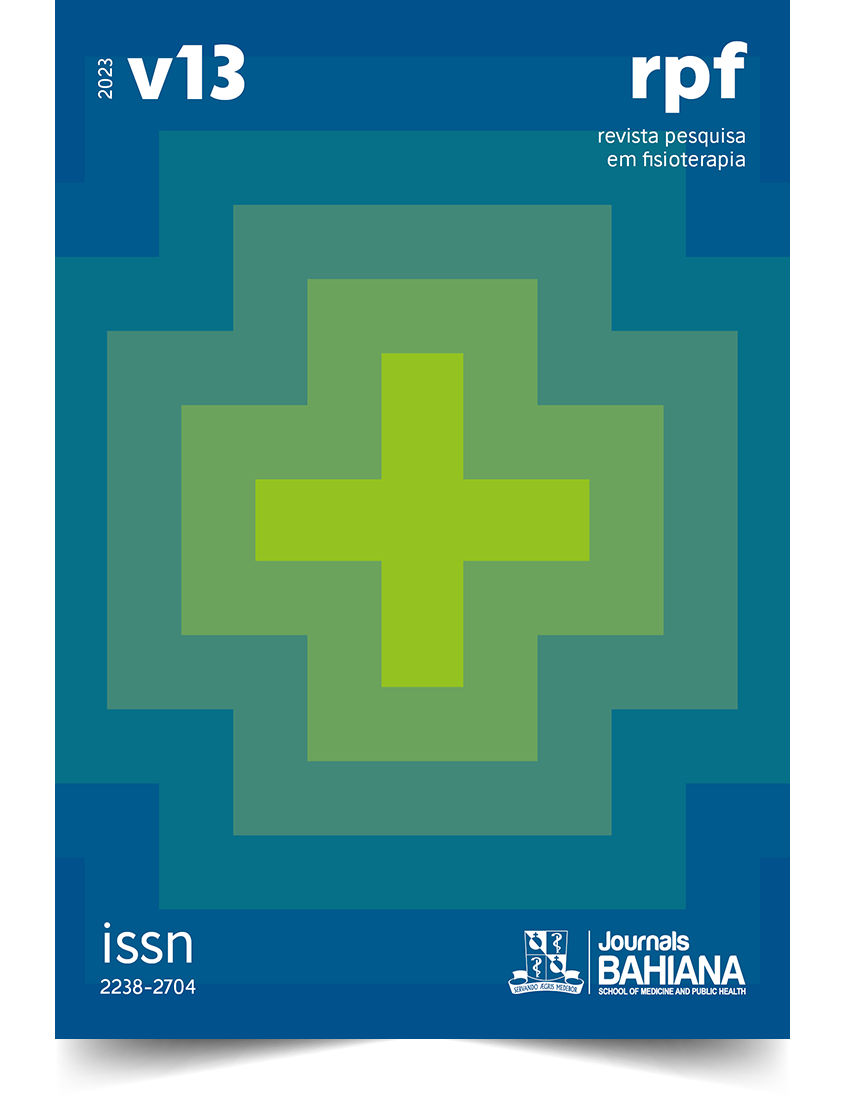O brincar como estratégia no atendimento fisioterapêutico da criança hospitalizada sob a percepção do acompanhante: um estudo transversal descritivo
DOI:
https://doi.org/10.17267/2238-2704rpf.2023.e5127Palavras-chave:
Criança Hospitalizada, Fisioterapia, Pediatria, Jogos e Brinquedos, FamíliaResumo
INTRODUÇÃO: Relatar a percepção familiar e/ou do acompanhante em relação à importância da utilização do brincar como recurso no tratamento fisioterapêutico de crianças hospitalizadas. MÉTODOS: Trata-se de um estudo descritivo de corte transversal. A população do estudo foi composta por acompanhantes das crianças admitidas na Enfermaria Pediátrica do Hospital Geral Roberto Santos e em acompanhamento fisioterapêutico. Foram coletados dados secundários para confirmação do tempo de início do atendimento com a equipe de Fisioterapia e dados primários por meio da aplicação de formulário no período de abril a junho de 2022. O instrumento foi composto por blocos de questões sociodemográficas, atividades sociais da criança anteriormente à hospitalização, comportamento da criança durante a hospitalização. Outrossim, aderência/aceitação ao tratamento, reação emocional e interesse durante e após intervenção utilizando o brincar. RESULTADOS: Foram entrevistados um total de 37 acompanhantes. Em relação às características sociodemográficas das crianças, 64,9% foram do sexo masculino e a idade de maior frequência foi entre dois a cinco anos. No que se caracteriza o humor da criança perante a hospitalização, antes da intervenção 81,1% relataram choro e 64,9% medo. Por fim, 59,5% dos acompanhantes salientaram ótima aderência/aceitação, 75,7% mencionaram melhora do humor, além de 83,8% classificarem como ótimo o interesse e a interação da criança. CONSIDERAÇÕES FINAIS: Constatou-se, com base na percepção dos acompanhantes, que o brincar como ferramenta coadjuvante das condutas fisioterapêuticas na enfermaria pediátrica é importante no tratamento da criança hospitalizada, pois melhora o humor, a aceitação, interação/interesse durante e depois intervenção, o que torna o cuidado mais integral e humanizado.
Downloads
Referências
(1) Queiroz ACO. Perception of the accompanier on a ludic project in a regional hospital. Part [Internet]. 2018;1(31):115-27. Available from: https://periodicos.unb.br/index.php/participacao/article/view/20154
(2) Sousa LD, Gomes GC, Silva MRS, Santos CP, Silva BT. Family in the paediatrics unit: nursing team's perception about the caring dimension. Cienc enferm. 2011;17(2):87-95. http://dx.doi.org/10.4067/S0717-95532011000200010
(3) Silva MKCO, Ferraz LCC, Farias MB, Januário JKC, Vieira ACS, Moreira RTF, et al. The use of play in the pediatric hospitalization scenario. Rev enferm UFPE on line. 2019;13:e238585. https://doi.org/10.5205/1981-8963.2019.238585
(4) Aranha BF, Souza MA, Pedroso GER, Maia EBS, Melo LL. Using the instructional therapeutic play during admission of children to hospital: the perception of the family. Rev Gaúcha Enferm. 2020;41:e20180413. https://doi.org/10.1590/1983-1447.2020.20180413
(5) Santos AC, Jesus ALS, Sampaio ACRI, Mazarro CJS, Raimundo RJS. The role of the toy in physiotherapy: contributions of psychomotricity to pediatric physiotherapy care. Rev Inic Cient Ext. [Internet] 2022;5(1):778-88. Available from: https://revistasfacesa.senaaires.com.br/index.php/iniciacao-cientifica/article/view/344
(6) Antão C, Rodrigues N, Sousa F, Anes E, Pereira A. Hospitalization of the child: parental feelings and opinions. Revista INFAD de Psicología [Internet]. 2018;2(1):125-33. Available from: https://www.redalyc.org/articulo.oa?id=349856003013
(7) Fujisawa DS, Manzini EJ. Professional training in the physiotherapy: the use of play activities in the treatment of children. Rev bras educ espec. 2006;12(1):65-84. https://doi.org/10.1590/S1413-65382006000100006
(8) Azevedo-Santos IF, Santos MJG, Souza TC, Alves VC, Barreto LCLS. Perception of physiotherapy students about the humanized treatment of hospitalized children. Journal of Health Connections [Internet]. 2020;10(3):98-110. Available from: http://periodicos.estacio.br/index.php/journalhc/article/view/8528
(9) Hockenberry MJ, Wilson D. Wong Fundamentos de enfermagem pediátrica. 9a. ed. Rio de Janeiro: Elsevier; 2014
(10) Piva EK, Cardoso JVC, Schwartz LNM. Ludicity and physiotherapeutic treatment of children with autism: a literature review. Revista Brasileira de Educação e Inovação da Univel (REBEIS). [Internet]. 2022;1(2). Available from: https://periodicos.univel.br/ojs/index.php/rebeis/article/view/150
(11) Franco LF, Bonelli MA, Wernet M, Barbieri MC, Dupas G. Patient safety: perception of family members of hospitalized children. Rev Bras Enferm. 2020;73(5):e20190525. https://doi.org/10.1590/0034-7167-2019-0525
(12) Ferreira FA, Silva SRM, Santos MCS, Silva AM, Freitas RSC, Gouveia MT, et al. Perception of the hospitalized child's companion in relation to therapeutic toys. Rev enferm UFPE on line. 2018;12(10):2703-09. https://doi.org/10.5205/1981-8963-v12i10a236309p2703-2709-2018
(13) Moreira-Dias PL, Silva IP. The use of the toy during the treatment of children with cancer: perceptions of the multidisciplinary team. RBC. 2018;64(3):309-15. https://doi.org/10.32635/2176-9745.RBC.2018v64n3.28
(14) Silveira KA, Lima VL, Paula KMP. Stress, pain, and coping in hospitalized children: relations with family stress. Rev. SBPH [Internet]. 2018;21(2):5-21. Available from: http://pepsic.bvsalud.org/scielo.php?script=sci_arttext&pid=S1516-08582018000200002&lng=pt&nrm=iso
(15) Vandenbroucke JP, Von Elm E, Altman DG, Gøtzsche PC, Mulrow CD, Pocock SJ, et al. Strengthening the reporting of observational studies in epidemiology (STROBE): explanation and elaboration. PLoS Medicine. 2007;4(10):e297. https://doi.org/10.1371/journal.pmed.0040297
(16) Menezes MS, Maia IBC. Family participation in the hospitalized child care process. Serv. Soc. & Saúde. 2020;19:e020005. https://doi.org/10.20396/sss.v19i0.8661082
(17) Biasibetti C, Hoffmann LM, Rodrigues FA, Wegner W, Rocha PK. Communication for patient safety in pediatric hospitalizations. Rev Gaúcha Enferm. 2019;40(esp):e20180337. https://doi.org/10.1590/1983-1447.2019.20180337
(18) Sari FL, Marcon SS. Participation of the family in physical therapy treatment of children with cerebral palsy. Rev Bras Crescimento Desenvolvimento Hum. 2008;18(3):229-39. https://doi.org/10.7322/jhgd.19886
(19) Chiavon SD, Brum CN, Santos E, Sartoretto EA, Zuge SS, Gaio G, et.al. Use of the therapeutic play for children who experiences the hospitalization process: a narrative review. BJHR. 2021;4(1):382-98. https://doi.org/10.34119/bjhrv4n1-031
(20) Ribeiro WA, Coutinho VVA, Eduardo CRB, Silva Neto PF, Pereira BVO, Costa VS, et al. Contributions of therapeutic play in the care process for hospitalized children: a study of the literature. Res. Soc. Dev. 2020;9(7):e1000974706. http://dx.doi.org/10.33448/rsd-v9i7.4706
(21) Barroso MCCS, Santos RSFV, Santos AEV, Nunes MDR, Lucas EAJCF. Children’s perception of venipuncture through therapeutic toy. Acta Paul Enferm. 2020;33:e–APE20180296. https://doi.org/10.37689/acta-ape/2020AO0296
(22) Barroso MCCS, Cursino EG, Machado MED, Silva LR, Depianti JRB, Silva LF. The therapeutic play in nursing graduation: from theory to practice. Rev pesq cuid fundam. 2019;11(4):1043-47. http://dx.doi.org/10.9789/2175-5361.2019.v11i4.1043-1047
(23) Souza I, Ribeiro MM, Lemos LR. Utilização da gameterapia como ferramenta de inovação para a fisioterapia nos cuidados paliativos em crianças com leucemia. Rev Liberum Accessum. [Internet]. 2022;14(2):43-53. Available from: http://revista.liberumaccesum.com.br/index.php/RLA/article/view/159
Downloads
Publicado
Edição
Seção
Licença
Copyright (c) 2023 Stephanie Barbosa Barreto Santos, Maria Carolina de Britto Andrade

Este trabalho está licenciado sob uma licença Creative Commons Attribution 4.0 International License.
Esta obra está licenciada com uma Licença Creative Commons Atribuição 4.0 Internacional.



